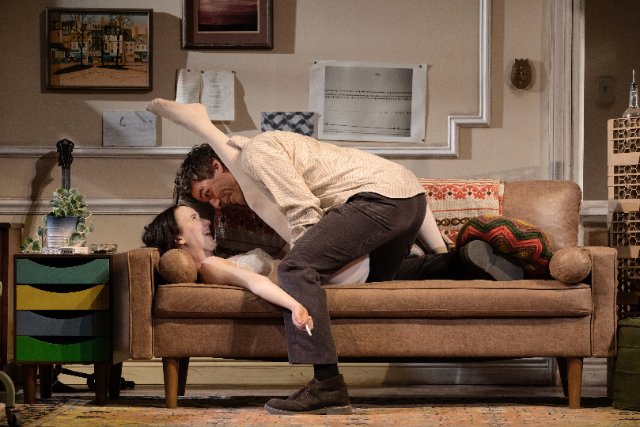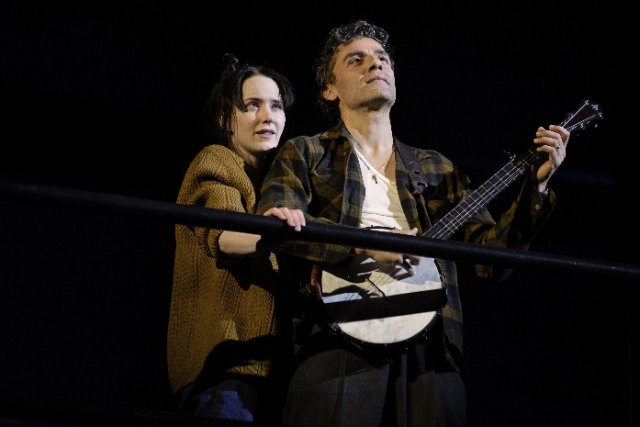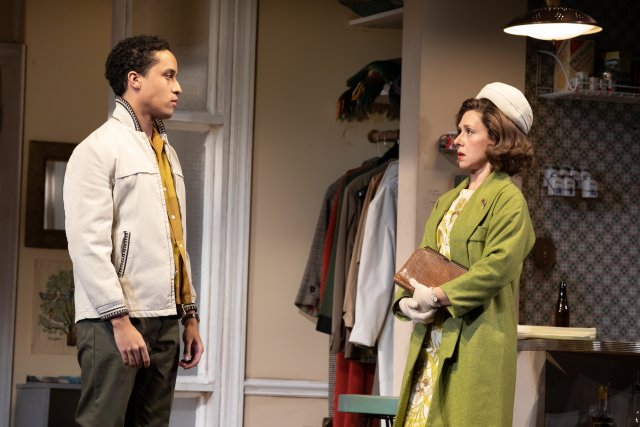Lorraine Hansberry at BAM
The Sign in Sidney Brustein's Window Revived
By: Susan Hall - Feb 28, 2023
The Brooklyn Academy of Music is mounting Lorraine Hansberry’s second play, The Sign in Sidney Brustein’s window at the Harvey Theater. Anne Kauffman, who directed the work at the Goodman Theater in Chicago in 2016, directs.
It is a tough play that survived 101 performances during its first run on Broadway because actors in other productions would step forward and promote it at the end of their own shows. It has not been often performed.
Playwright Lorraine Hansberry wrong foots her characters and the audience. Only a small Greek chorus of three sisters, Iris, Mavis and Gloria, portray expected roles.
Football star, tv reporter and college classmate of Hansberry’s, Bob Teague said that Hansberry was the only person he knew who could whip up a protest sign in minutes with her own hands. Signs were important to her.
The political sign in Sidney’s window signals his move from political apathy to pseudo-activism.
Sidney is an ambitious, radical Jew, one that would become familiar in New York in Greenwich Village and then move uptown to the Bernsteins’ party as portrayed by Tom Wolfe not long after Hansberry’s play was first produced.
Oscar Isaac plays Sidney. As the play opens, he is teasing his wife Iris, an actress-wannabe waiting on tables. He wants her to dance. He wants her to let her hair down. He wants her to perform for him. She does. We are completely engaged by this sexy actor and then a bit horrified by the role in which he casts his wife.
Iris too is completely engaging. Played by Rachel Brosnahan, who has made her mark as the Marvelous Mrs. Maisel, and in many other blistering performances, Iris progresses from a devoted 'other' to an adventuresome 'outsider. '
This casting allows director Kauffman to show us what fun and how awful a woman’s role can be.
The cast is uniformly terrific. Glenn Fitzgerald as the playwright who lives next door is compelling. An Edward Albee-like figure, his play about two married men who live in a refrigerator has recently become a big hit (smashing as reported on this stage, that is). Sidney wants David to write a role for Iris. David is not going to help save their marriage this way.
Hansberry portrays the difference between male absurdism and the oppressed yet enriched experience of women. Women force us back from absurdism into linear story development, old-fashioned yet true. Miriam Silverman as Mavis is given the most developed role. Her dialogue is snappy and fulsome.
There are two subjects in the play – and they are surprising for an audience that assigns the role of Black playwright to Hansberry. Howard Cruse commented that Hansberry moved from the appellation Black to simply playwright with this work.
Sidney appropriates a radical stance to satisfy his neighbors and integrate into the beatnik community in Greenwich Village of which he is a member. His wife, and her sisters, whose part-Greek heritage is signaled by their last name, form a chorus, echoing Simone De Beauvoir, an important contributor to Hansberry’s ideas. Women for Hansberry are more authentic than men. Their underdog position has enriched them. When they can push out, they bring richer and more complex characters to the fore.
Director Kauffman clearly senses this as she places two of the sisters and one prospective husband sitting in chairs on the floor of the Harvey Theater, looking up at the stage.
Sidney flops as a radical. You can imagine him appearing at the infamous Berrnsein party depicted in Tom Wolfe’s Radical Chic. Wolfe saw the appropriation of guilt spiked with social consciousness, not an effort of Blacks and whites to seriously work for equality and social justice. Lincoln Center’s current effort to make their institutions as attractive a destination for Blacks as Selma has some of the same flavor.
See The Sign in Sidney Brustein’s Window. You’ll enjoy it and maybe learn something too.
At the Harvey thru March 24th. Tickets here.








